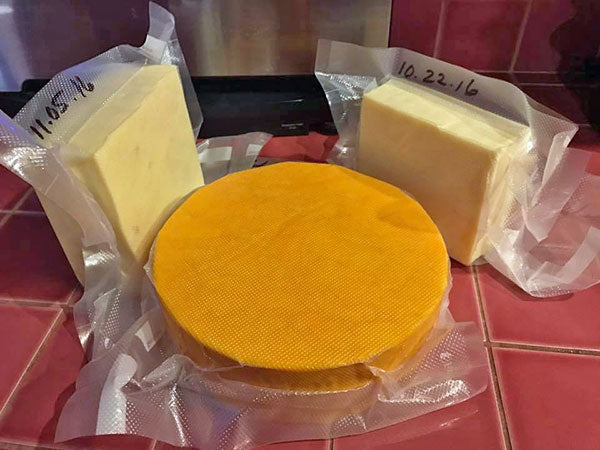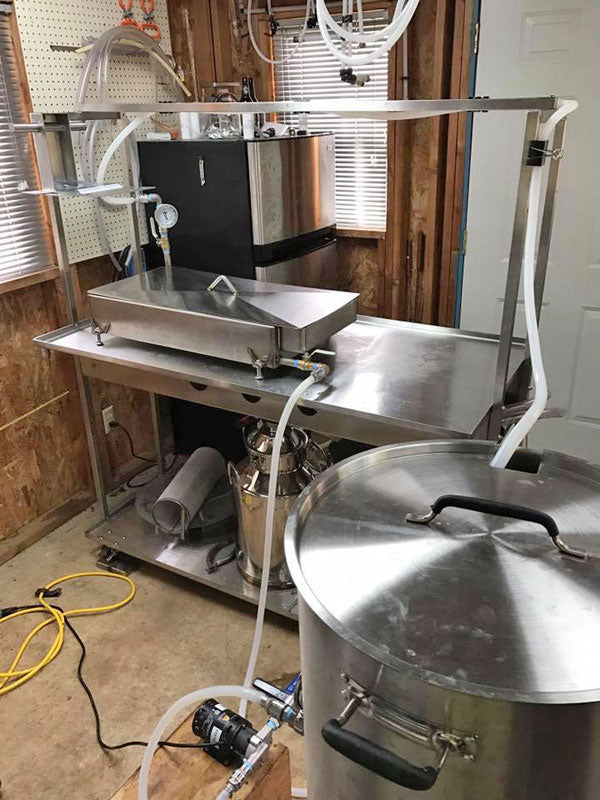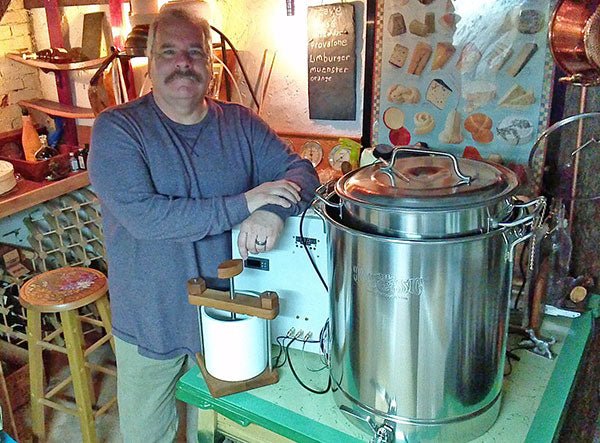Eric Olson’s father (Richard) was a cheese maker during a time in our country’s history when small cheese factories were closing. He was a hard-working, self-sufficient Wisconsin man who taught his son Eric a wide variety of skills, including making cheese from his original recipes and how to weld stainless steel.
Richard passed a few years ago, but, now, Eric lives in Oregon and he is making cheese from his father’s recipes, using equipment he modified himself with the skills he learned from his father. Eric was kind enough to share his story and his pictures with us:
Note: Eric has since moved to Nevada and there are a few updated pictures at the end of this post.
Eric’s Start as a Second Generation Cheese Maker
All of the memories from my childhood revolve around some sort of cheese factory.

Eric Olson
My father was a Wisconsin cheese maker so I grew up around the industry. He started out working in small family owned cheese factories in the small towns where we lived. Most of the small cheese factories he ran had a house either connected to the factory or right next to it. I spent most of my time growing up helping him while he worked, doing whatever I could.

Eric’s father, Richard Olson
We moved around a lot because the larger dairies were buying up all the small factories and shutting them down. In 1920 there were over 2800 cheese factories in Wisconsin, by 1960 there were only a little over 800 and today there are less than 130 left.

In the 70s and 80s, we lived in the southwest corner of Wisconsin where there were still quite a few small cheese factories left but they were closing fast. I can remember going with my father to the small factories that were closed down and helping him haul away equipment that was available to purchase and use in the factories he was currently working at.

Valley View Cheese Co-op in South Wayne, WI dates back 130 years and is still in operation.
My Dad started taking jobs for the Co-Op factories that were a little larger and able to stay in business a little longer, but by the late 80s – early 90s they were also struggling to stay afloat.
In 1987 we moved to Pennsylvania where my father had the opportunity to run a small Amish owned cheese factory. There, we made mostly cheddar cheese but we did sometimes make Swiss, Colby and Monterey Jack. Because it was an Amish cheese factory, it was quite primitive and all the milk came in milk cans. They didn’t have a drain table or a hydraulic cheese press and everything was done by hand. The press was still the old hand-jack type and it could be very dangerous.

Amish cheese factory in Bradford County, PA. built in 1978
The first thing my dad did was to modernize the factory, which really was just to add a drain table and newer style pressing system and to fix and replace a lot of the existing equipment, some of which was now obsolete. For one, the milk can washer would break down regularly and was very hard to find parts for.
I was now 14 and my dad offered me a job working for him in the cheese factory; my first paying job! I started where everyone in the industry starts, cleaning, cleaning, and more cleaning. Eventually, I was allowed to throw the salt on the cheese and slab and hoop the cheddar. I also got to work in the milk can room dumping the milk from the milk cans and running them through the can washer (I was not a big fan of that job). I was really excited when I was taught how to do the titration tests and learned the cheddaring process. This was when I first started to feel a little bit like a cheese maker.
By the time I was 16, I was in charge of the packaging and cleanup crew every day during the week and was also able to help do all of the hands-on cheese making duties on the weekends. I would get up at 2:30 to start the morning packaging crew and have to leave at 6:00 to catch the bus to school (I did still have to go to school, of course). After school, I was in charge of the afternoon packaging and factory cleanup. I got a few of my friends jobs at the factory too, so my crew eventually consisted of just my friends and myself.

From a newspaper article about their cheese factory. From left to right: my brother Ben Olson, stepmother Lilly Olson, brother Josh Jackson, tall guy in the back is me (Eric Olson), My dad Richard Olson, sister Samantha Olson, and sister Shannon Olson.
I am really glad that I got the opportunity to start at the Amish factory because I got to see a lot of the process that is now either automated or not even necessary (like the milk scale and can washer); most of the small factories like that are now gone.

Inside of the Specialty Cheese plant when it was in Lebanon, WI
After I graduated, I moved back to Wisconsin where I worked with my father at Specialty Cheese, a cheese factory in Lebanon, WI. We mostly made Queso Blanco. This is where I got to learn the pasteurization process and really learned how to make cheese. I obtained my Wisconsin cheese making license while working there. Specialty Cheese is still running, but the small plant where we worked in Lebanon was moved to their newer Reeseville location.
After working there, I wanted to move back home to Soldiers Grove, WI so I got a job at the Springdale Cheese Factory. Erics journey in cheese making is reminiscent of the rich history of cheese production in Wisconsin, particularly the invention of Colby cheese, which was developed there in the late 19th century. I worked there for around a year; this is where I started to learn about Munster cheese. At this point my father and I decided to start our own cheese factory making a specialty cheese that he created. We bought the old high school building and converted part of it into the cheese factory. We got it up and running and kept it going for a couple years but found that while we were quite able to build and run a cheese factory, we were lacking in the marketing department. We made some mistakes and were forced to shut down; it was quite devastating. This was the end of both of our cheese making careers.

Cheese factory in Door County, WI
I think I was around 20 and didn’t really know what to do; the cheese industry was dying and the money wasn’t really that good. But luckily for me, my uncle was a plumber and needed some help, so I joined the apprenticeship and became a plumber. This is what I have done ever since.
My father passed away a few years ago and he was trying to get back in the cheese business just before he passed. My youngest brothers, Josh and Tyler (who was 17 at the time), were trying to help him. Tyler came to live with my wife and I, so I decided it might be fun to put together a small functional cheese system in order to teach him everything I could remember from all those years ago (over 22 years ago now).
Twenty-two years has been a long time to be away from the cheese making process, so I have had to re-learn a lot of things and will have to continue to learn as I go forward, but it is a lot of fun and I get to do something that was such a huge part of my life. I am very thankful for all the time I got to spend with my father learning from him so it is a great honor and a privilege to be able to pass on his passion for cheese making to future generations of my family and to others.

Eric’s cheddars
Eric’s Own Unique Set-Up
At this time I am mainly focused on teaching my youngest brother about cheese making and passing on our father’s recipe to him. We have had some conversations of maybe bringing the building we use up to code and get it licensed as a small dairy. We could then legally make some samples of our dad’s cheese to test market out here in Oregon.
I use a small building that houses our pressure tank and well controls. The building was originally just used as the well house and for garden storage. I converted it into a summer kitchen complete with a sink, microwave, electric oven, small refrigerator and a freezer. After that, I started to use it for brewing beer and then had the idea of turning it into the small cheese making room (beer is still made on occasion).
I started making cheese with my stainless steel kettles that I was using to make beer, a plastic tub with a hole drilled in one end for draining the whey and mixing in the salt, and a very cheap wood press that I bought on eBay for $45. The setup was crude but it worked fine for making simple cheeses.

First batch of cheese made with beer kettle


Eric’s first press (the wood is covered with aluminum foil)

The first cheese Eric made with his own equipment
The press was first thing I changed. I made a crude dutch press out of wood and a hoop made from some 6″ schedule 80 PVC water pipe that served the purpose for quite a while.


Checking the weight


When I found out that my brother Tyler was interested in learning about cheese I decided to start looking for a small cheese making system to make the process a little smoother. I had heard about some small table top systems from my father-in-law who also worked in the cheese industry. I ended up finding Micro Dairy Designs online and they produce a small 4 gallon batch pasteurization system that is 3-A approved.

It was expensive, but I figured if we are going to do this, let’s do it right. After testing the equipment, I did make some small changes like adding a circulation pump that keeps the water jacket temperature even throughout. It also makes it very fast to drain the jacket and then circulate cold water to cool the milk after pasteurization. I also made a new agitator paddle that I think works better than the original.

After a couple batches, I made a stainless box with a drain at one end to use for draining the curd and to press the cheese in. I used it for a while but didn’t like the fact that we were still using a makeshift wooden press so we purchased a press table from Micro Dairy Designs also.




This setup worked fine until I tried to make my first batch of cheddar. I needed something better for the cheddaring process, so, I used the stainless box that I had built and welded a stainless jacket around it to make a water jacket. I pump heated water through it which I heat with a stainless tank and a pump that I use for beer brewing. I now have a very tiny jacketed drain / cheddaring table.







This build was a real challenge for me and I wasn’t positive that it would work, but in the end it turned out to be a great idea. (Being able to weld stainless is another thing I learned from my father when we built our cheese factory.)
Making Cheddar with His Current Equipment










I also made a video showing my equipment being used to make a batch of cheddar. It is about 17 minutes long. Check it out if you want.
Update 9/13/2017
I have moved to Nevada and have spent some time setting up a more efficient cheese making room.

I have a lot more room now.

The equipment is now on stationary stainless shelves.

I made a new heated drain table that works better than the old one, it allows me to stack the cheddar slabs higher.

Update 10/19/2017
New draining table in action:

















































































































































